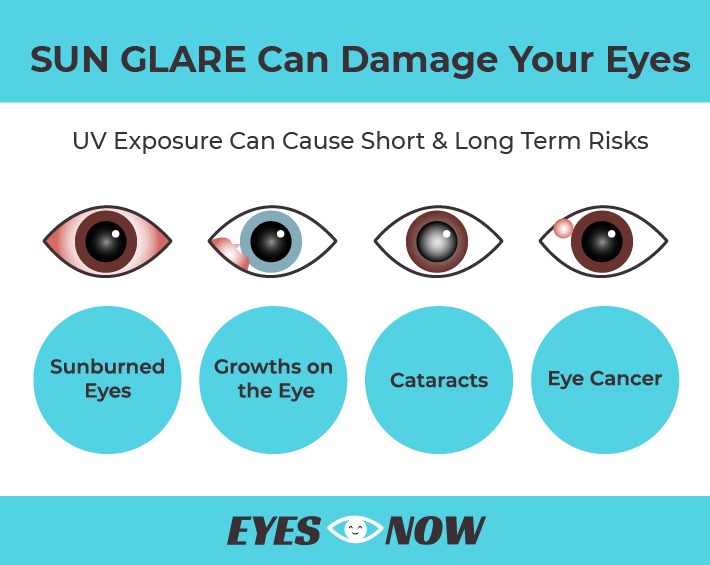Have you ever noticed that your eyes water in the cold? They get scratchy when it’s dry out? And, you naturally squint when it’s sunny?
Your eyes are sensitive to different weather conditions, but probably the most harmful is exposure to the sun’s ultraviolet (UV) rays. Whether you’re out in the sun directly, or it’s reflecting up at you, you should take care of your eyes so they don’t get damaged.
Changes in your eyes and vision can happen gradually, sometimes without you noticing right away, or they can happen suddenly. If you experience an eye care emergency, get in touch with your optometrist as soon as possible.
Harmful UV Rays Can Damage Your Eyes
In a string of Instagram posts at the beginning of June, American-Brazillian actor and model Camila Alvez McConoughey — who is married to Matthew McConoughey — spoke up about the dangers of UV light exposure.
She posted photos of herself in a hospital bed with her eyes covered. Camila had to undergo eye surgery to save her vision after spending too much time in the sun.
Later, she showed a post-surgery photo of herself wearing sun-blocking goggles, saying “I am feeling good guys….JUST REMEMBER to wear your sunglasses.”
Camila’s story ends in recovery, but it could have gone a very different way.
Symptoms of too much sun exposure include:
- Red, uncomfortable eyes
- Tearing or watery eyes
- Blurred vision or light sensitivity
- A gritty sensation in the eyes
- Temporary vision loss
- Changes in color vision
- Swelling around the eyes
- Headaches

Types of Sun Radiation
There are 2 types of UV radiation that affect us. Each of the types come with their own risks, which is why it’s important to protect your eyes by wearing sunglasses and hats.
UVA
The lowest-energy UV radiation is UVA. This type accounts for 95% of the sun’s rays and can cause tanning and sunburning. UVA is not typically associated with major skin or eye problems, but it can affect the cornea.
UVB
If you’ve ever burned quickly or had a suntan, it was likely the work of UVB rays. Exposure to UVB can cause damage to the eye and skin quickly.
UVC
This type of UV radiation gets filtered out by the ozone, so we don’t have to worry about it — which is good, because it is the most harmful.
Where Sun Glare Comes From
Sun glare is most obvious when it’s right in your eyes. You’re probably squinting or shielding yourself from the rays with your hands.
But, we get sun glare from more than just the largest star in our galaxy. It reflects off many different surfaces, often without us even noticing. Preserve your eye health by being aware of the risks.
Summer
In the warmer months, dermatologists ask people to take precautionary measures to protect their skin from harmful UV rays that can cause premature aging and skin cancer.
Your eyes are equally as vulnerable when you’re out in the sun. The strong summer rays bounce back off of pavement, water, grass, and soil. According to the World Health Organization, dry beach sand can reflect 15% of the rays back at us, and seafoam reflects about 25%. Higher elevations have higher amounts of UV as well.
So, while you might not be in direct sunlight, take a look around to see how the sun could be reflecting up at you.
Winter
Just because it’s colder outside doesn’t mean the sun’s rays aren’t visible. Wet pavement and puddles can reflect the UV rays up at you. If you’re not in direct sunlight, watch for glare from windows and vehicles.
Pack your sunglasses and don’t forget to wear them on sunny days, or if you have sun reflecting at you.
Indoors
The sun isn’t the only thing that emits harmful UV rays. Welding is a common cause of eye damage. You can also absorb UV rays from tanning beds and lasers, among other things.

What Does it Do?
Sun damage can cause many short-term and long-term issues. Some damage may heal on its own, and some could be permanent. You might not even know you have damaged your eyes until later in life.
Photokeratitis (Welder’s Eye)
Also known as “welder’s eye,” photokeratitis is a temporary condition similar to having a sunburn on your cornea. You can get photokeratitis from too much direct or indirect sunlight.
If you expose your eyes to too much direct UV, you could burn your retina, which is more severe and longer-lasting than photokeratitis.
If you think you have damaged your eyes in the sun:
- Remove contact lenses if you’re wearing them
- Get out of the sun and into a dark room
- Remove makeup from around your eyes
- Use a cool compress to reduce swelling
- Resist the urge to rub your eyes
- Use artificial tears to lubricate eyes
- If symptoms persist, talk to your doctor
Permanent Damage
Sometimes we do long-term permanent harm to our eyes, which can cause eye conditions as we age.
Overexposure to the sun can cause your eye to grow a pterygium. The Spanish term for pterygium is carnicidad. A pterygium is an elevated, wedge-shaped growth that comes across the white of your eye (sclera) and starts to cover up your cornea. These are non-cancerous growths, but they can lead to permanent scarring.
Chronic UV exposure could also lead to a pinguecula, which is characterized by an abnormal growth on the tissue that covers the outermost layer of your eye, under your eyelid. Pinguecula is yellowish and raised, and typically appear on the side of the eye closest to your nose.
A pterygium (tuh-RIJ-ee-uhm) is an elevated, wedged-shaped growth of the scleral conjunctiva that invades the cornea. Pterygia are non-cancerous growths, but they contain blood vessels and can form scar tissue that can permanently disfigure the eye.
A pinguecula (pin-GWEK-yoo-lah) is a yellowish, slightly raised thickening of the conjunctiva on the white part of the eye (sclera), close to the edge of the cornea.
Both these conditions are a result of the sun damaging tissue due to chronic harmful UV exposure.
Although cataracts typically develop later in life, excess sun exposure can cause them to appear earlier. Sun damage is also associated with macular degeneration.
You might not be affected immediately, but eye cancers can develop over time. Every time you expose your eyes to the sun, your risk factor for developing these long-term conditions increases. Surfers, farmers, anglers, and other people who participate in outdoor activities could also develop growths on their eyes.
Protect Your Eyes
Like they say, an ounce of prevention is worth a pound of cure.
In this case, the best prevention available is to wear sunglasses. You can also wear a hat to cover your face and eyes and sit in the shade when possible. Be aware of your surroundings and how the sun’s glare could be reflecting up at you from other surfaces.
When choosing sunglasses, look for these qualities:
- Provides 100% UV or UV400 protection
- Blocks both UVA and UVB rays
- Bigger is better (covers more area)



